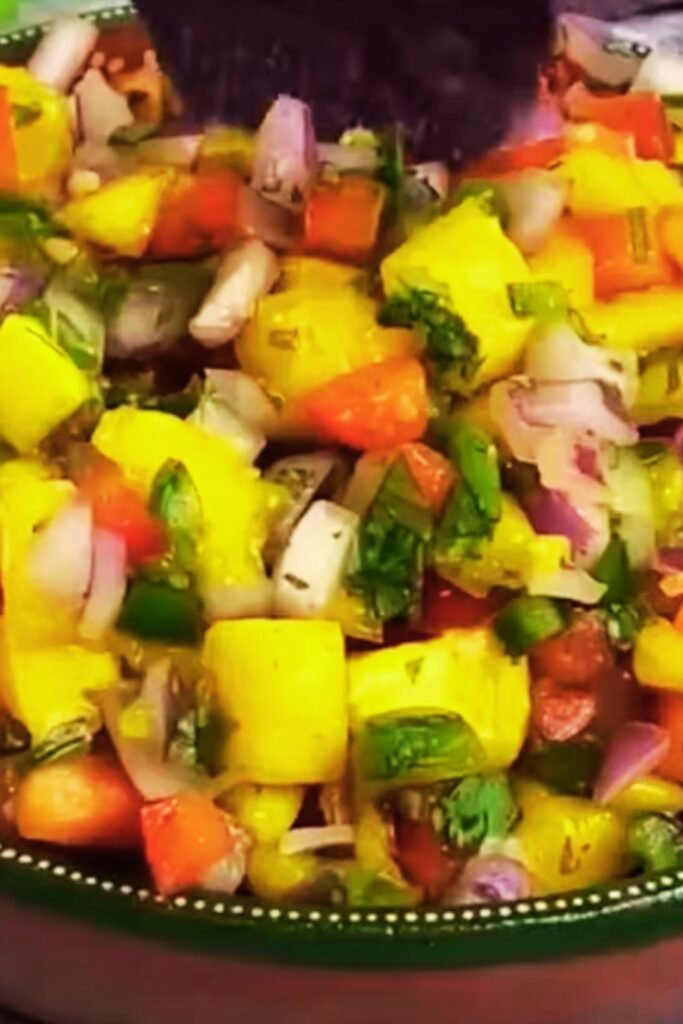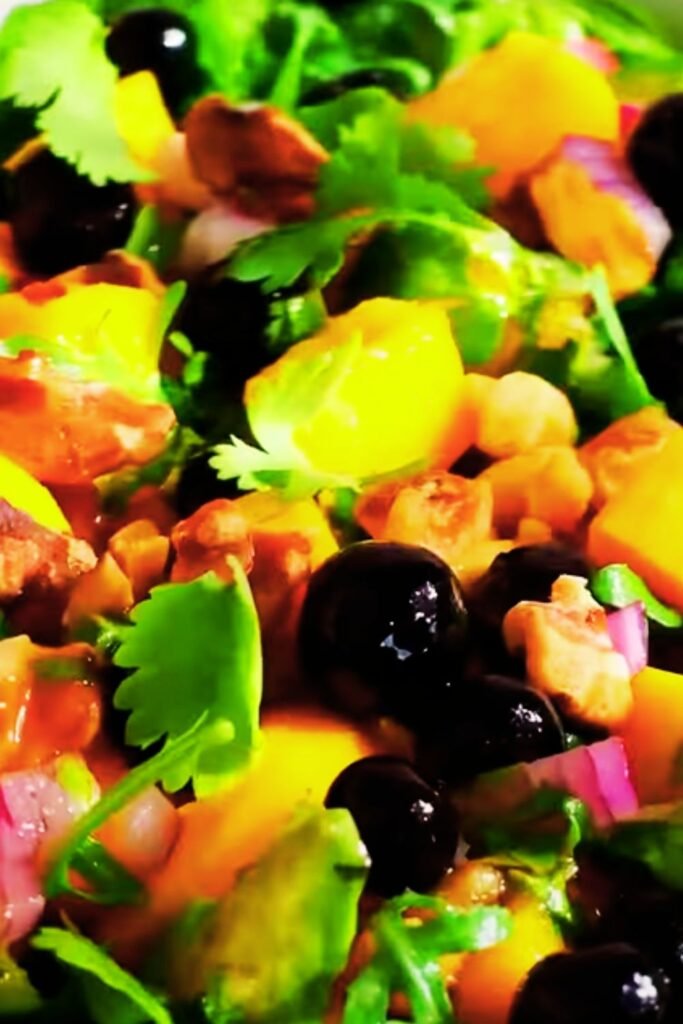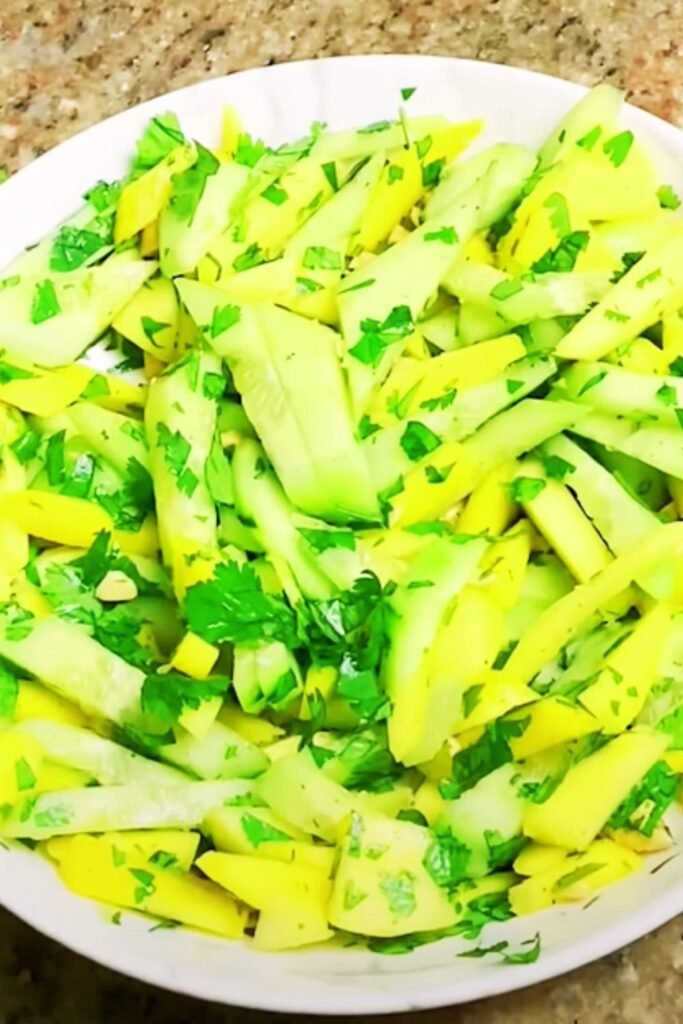Last summer, during a particularly sweltering afternoon, I found myself staring into my refrigerator, desperately seeking something that wouldn’t require turning on the oven. That’s when I spotted a perfectly ripe mango sitting next to some crisp cucumbers, and something clicked. What started as a moment of culinary desperation has become one of my most requested recipes – a vibrant mango cucumber salad that manages to be both incredibly simple and surprisingly sophisticated.
The beauty of this dish lies in its contradictions. It’s tropical yet refreshing, sweet yet savory, exotic yet familiar. Every bite delivers a symphony of textures and flavors that somehow makes perfect sense together. I’ve served this salad at everything from casual backyard gatherings to elegant dinner parties, and it never fails to spark conversation about its unexpected deliciousness.
Essential Ingredient Definitions
Mango Classifications: : Ataulfo Mango – Small, golden variety with creamy texture and minimal fiber content : Tommy Atkins – Large, red-skinned variety commonly found in supermarkets with sweet flesh : Kent Mango – Medium to large fruit with smooth texture and rich, sweet flavor profile : Keitt Mango – Green-skinned variety that remains green when ripe, offering sweet, firm flesh : Haden Mango – Round, red-yellow fruit with aromatic, sweet flesh and moderate fiber
Cucumber Varieties: : English Cucumber – Long, thin-skinned variety with minimal seeds and crisp texture : Persian Cucumber – Short, smooth-skinned variety with tender flesh and mild flavor : Kirby Cucumber – Small, bumpy-skinned variety traditionally used for pickling : Armenian Cucumber – Actually a type of melon, but used like cucumber with mild taste : Lemon Cucumber – Round, yellow variety with crisp texture and subtle flavor
Flavor Enhancers: : Lime Zest – Outer peel containing essential oils that provide intense citrus aroma : Fresh Mint – Cooling herb that adds refreshing qualities and aromatic complexity : Cilantro – Bright, slightly peppery herb that enhances overall flavor depth : Thai Basil – Sweet basil variety with subtle anise notes and floral undertones : Red Onion – Sharp, pungent variety that adds color contrast and flavor balance
Complete Recipe Foundation
Primary Ingredients
Core Components: • 2 large ripe mangoes, peeled and cut into 3/4-inch cubes • 2 English cucumbers, sliced into 1/4-inch half-moons • 1/2 small red onion, thinly sliced into crescents • 1/4 cup fresh mint leaves, roughly chopped • 2 tablespoons fresh cilantro, finely chopped • 1 small jalapeño, seeded and minced (optional)
Dressing Elements: • 3 tablespoons freshly squeezed lime juice • 2 tablespoons extra virgin olive oil • 1 tablespoon raw honey or pure maple syrup • 3/4 teaspoon kosher salt • 1/4 teaspoon freshly cracked black pepper • 1/2 teaspoon lime zest
Detailed Preparation Method
Mango Preparation Steps:
- Select mangoes that yield slightly to pressure but maintain firmness
- Stand mango upright and slice down both sides of the flat central pit
- Score the flesh in a crosshatch pattern without piercing the skin
- Push the skin from underneath to invert the mango half
- Carefully slice away the cubes with a sharp knife
- Place cubes in a large mixing bowl and set aside
Cucumber Processing:
- Rinse cucumbers thoroughly under cold running water
- Trim both ends and slice into uniform half-moon shapes
- Arrange slices on paper towels and sprinkle lightly with salt
- Allow to rest for 15 minutes to draw out excess moisture
- Pat completely dry with fresh paper towels before adding to mango
Dressing Assembly:
- Combine lime juice and honey in a small bowl
- Whisk vigorously until honey dissolves completely
- Gradually add olive oil while whisking continuously
- Season with salt, pepper, and lime zest
- Taste and adjust seasoning as needed

Comprehensive Nutritional Analysis
Understanding the nutritional profile of this salad has helped me appreciate why it leaves me feeling so energized and satisfied. The combination provides an impressive array of vitamins, minerals, and beneficial compounds.
| Nutrient Component | Mango (1 cup) | Cucumber (1 cup) | Combined Per Serving | % Daily Value | Health Benefits |
|---|---|---|---|---|---|
| Vitamin C | 67mg | 4mg | 71mg | 79% | Immune support, collagen synthesis |
| Vitamin A | 1,262 IU | 86 IU | 1,348 IU | 27% | Vision health, immune function |
| Folate | 71mcg | 19mcg | 90mcg | 23% | DNA synthesis, cell division |
| Potassium | 325mg | 152mg | 477mg | 14% | Heart health, blood pressure |
| Dietary Fiber | 3g | 1g | 4g | 16% | Digestive health, satiety |
| Antioxidants | High | Moderate | High | N/A | Anti-inflammatory properties |
| Water Content | 84% | 96% | 90% | N/A | Hydration, cooling effect |
Unique Nutritional Advantages: The mango provides beta-carotene, which converts to vitamin A in the body and supports healthy vision and immune function. Meanwhile, cucumbers offer silica, a mineral that supports connective tissue health and may contribute to healthier skin and hair.
Digestive Benefits: Mangoes contain digestive enzymes like amylase, which help break down carbohydrates and support optimal digestion. The high water content and fiber from both ingredients promote healthy gut function and regular elimination.
Hydration Properties: With its exceptionally high water content, this salad serves as an excellent hydration source, especially during warm weather or after physical activity. I often serve it during summer gatherings as a refreshing alternative to heavier dishes.
Creative Variations and Adaptations
Over the years, I’ve developed numerous variations that keep this basic recipe interesting and adaptable to different dietary needs and flavor preferences.
Mediterranean-Inspired Version: • Add 1/2 cup crumbled feta cheese for tangy richness • Include 1/4 cup kalamata olives for briny depth • Substitute fresh oregano for mint • Drizzle with premium olive oil and balsamic reduction
Asian Fusion Adaptation: • Incorporate 1 tablespoon rice vinegar for tangy acidity • Add 1 teaspoon sesame oil to the dressing • Include julienned red bell pepper for color and crunch • Garnish with toasted sesame seeds and crushed peanuts
Tropical Paradise Style: • Add 1/2 cup diced fresh pineapple for extra sweetness • Include 2 tablespoons unsweetened coconut flakes • Use coconut oil in place of olive oil • Garnish with chopped macadamia nuts
Southwestern Twist: • Add 1/2 cup corn kernels for sweetness and texture • Include diced avocado for creamy richness • Use lime juice generously with chili powder • Garnish with pumpkin seeds for additional crunch

Advanced Preparation Techniques
My approach to this salad has evolved considerably since I first started making it. These refined techniques ensure consistent, professional-quality results every time.
Mango Selection Mastery: The key to exceptional mango cucumber salad lies in selecting perfectly ripe fruit. I’ve learned to look beyond just color – the most reliable indicator is a gentle yield to pressure combined with a sweet, fruity aroma at the stem end. The skin should be taut without wrinkles or dark spots.
Cucumber Preparation Science: Salting cucumber slices isn’t just about removing moisture – it’s about concentrating flavor and improving texture. The salt draws out excess water through osmosis while slightly firming the cellular structure. This prevents the salad from becoming watery while intensifying the cucumber’s natural flavor.
Dressing Emulsification: Creating a stable, creamy dressing requires understanding basic emulsification principles. I always start by dissolving the honey completely in the lime juice before slowly adding oil while whisking continuously. This creates a temporary emulsion that coats ingredients evenly and prevents separation.
Knife Skills for Optimal Results: Consistent knife work makes a significant difference in both presentation and eating experience. I cut mango into uniform 3/4-inch cubes – large enough to provide satisfying bites but small enough to distribute evenly. Cucumber slices should be approximately 1/4-inch thick for optimal texture contrast.
Seasonal Sourcing and Quality Selection
Understanding seasonal availability and quality markers has dramatically improved my success with this salad.
Peak Season Timing: • Mangoes: May through September for domestic varieties • Cucumbers: June through August for best flavor and texture • Herbs: Spring through early fall for optimal freshness • Limes: Year-round availability with peak quality in winter
Quality Assessment Techniques: For mangoes, I look for fruits that yield slightly to pressure but aren’t mushy. The skin should have a sweet fragrance at the stem end. For cucumbers, I choose firm specimens with bright, unwrinkled skin. Any yellowing indicates overmaturity.
Storage Optimization: Mangoes should ripen at room temperature, then be refrigerated once ripe. Cucumbers store best in the refrigerator’s crisper drawer. Herbs maintain freshness when stored with stems in water and covered with plastic bags.
Storage Solutions and Meal Prep Strategies
Optimal Storage Methods: • Temperature: Maintain 36-40°F in refrigerator • Containers: Use airtight glass containers to prevent odor absorption • Separation: Keep dressing separate until serving time • Duration: Consume within 24-48 hours for best quality
Make-Ahead System: I’ve developed a three-day preparation system that allows for optimal freshness:
Day 1: Prepare and store dressing in refrigerator Day 2: Cut mango and cucumber, store separately Day 3: Combine ingredients 30 minutes before serving
Travel-Friendly Packing: For picnics or potlucks, I use a compartmentalized container system. The dressing goes in a small sealed container, while fruits and vegetables stay separate until assembly. This prevents sogginess and ensures optimal texture.
Serving Suggestions and Presentation Ideas
Elegant Presentation Options: • Serve in chilled glass bowls to enhance the refreshing quality • Garnish with additional fresh herbs for visual appeal • Create individual portions in clear cups for parties • Use hollowed-out mango shells as natural serving vessels
Pairing Recommendations: This salad complements grilled fish beautifully, particularly salmon or mahi-mahi. It also works wonderfully alongside spicy dishes, providing cooling relief from heat. I’ve found it pairs exceptionally well with rice dishes, adding freshness and acidity that brightens the entire meal.
Portion Sizing: As a side dish, I typically serve 1/2 cup portions. For a light lunch or appetizer, 3/4 cup portions work well. When serving as part of a larger meal, smaller portions allow guests to enjoy the flavors without overwhelming other dishes.

Troubleshooting Common Challenges
Watery Consistency Issues: This problem typically stems from inadequate cucumber preparation or overripe mango. The solution involves proper salting technique for cucumbers and careful fruit selection. I always pat cucumbers completely dry after salting and choose mangoes that are ripe but still firm.
Flavor Balance Problems: When the salad tastes flat or one-dimensional, it usually needs more acidity or salt. I add lime juice gradually while tasting frequently. Sometimes a pinch of salt is all that’s needed to brighten and balance the flavors.
Texture Deterioration: Mushy texture typically results from overripe mango or extended storage time. I now select slightly firmer mangoes and limit storage to 24 hours maximum. The key is finding mangoes that are sweet and aromatic but still hold their shape when cut.
Presentation Concerns: If the salad looks unappetizing or colors seem dull, it often indicates ingredient quality issues or improper storage. Fresh ingredients with vibrant colors make all the difference in both appearance and flavor.
Cultural Context and Global Inspirations
This salad draws inspiration from various international cuisines. Thai som tam features similar fresh fruit and vegetable combinations with bold flavors. Indian cuisine includes numerous mango-based preparations with different spice profiles. Mexican street food commonly pairs mango with lime and chili, creating similar flavor profiles.
Understanding these cultural connections has deepened my appreciation for why this combination works so effectively. It’s not just random ingredients – it represents flavor harmonies that different cultures have discovered through generations of culinary experimentation.
Questions and Answers
Q: How can I tell when a mango is perfectly ripe for this salad? I look for mangoes that yield slightly to gentle pressure but still feel firm overall. The skin should have a sweet, fruity aroma at the stem end without any fermented smell. Avoid mangoes with dark spots, wrinkled skin, or overly soft areas, as these indicate overripeness that will make your salad mushy.
Q: Can I prepare this salad completely ahead of time for a party? While I don’t recommend assembling the complete salad more than 2 hours in advance, you can prepare all components separately up to 24 hours ahead. Store the cut mango and cucumber in separate containers, keep the dressing refrigerated, and combine everything about 30 minutes before serving for optimal texture and flavor.
Q: What’s the best substitute if fresh herbs aren’t available? Fresh basil makes an excellent substitute for mint and provides a different but equally delicious flavor profile. If you only have dried herbs, use about one-third the amount and mix it directly into the dressing to rehydrate. However, fresh herbs really elevate this salad significantly.
Q: How can I make this salad more filling for a main course? I often add grilled protein like shrimp, chicken, or tofu to make it more substantial. You can also serve it over quinoa, rice, or mixed greens. Adding avocado slices increases the healthy fat content and makes it more satisfying. Nuts like cashews or almonds provide additional protein and pleasant crunch.
Q: Why does my salad become watery even after following the recipe? This usually happens when cucumbers aren’t properly prepared or when ingredients are stored together too long. Always salt cucumber slices and let them rest for 15 minutes, then pat them completely dry. Also, avoid combining ingredients more than 2 hours before serving to prevent moisture release.
Q: Can I use frozen mango if fresh isn’t available? While fresh mango is definitely preferred, properly thawed frozen mango can work in emergencies. Thaw it completely and drain any excess liquid before using. The texture won’t be quite as firm, but the flavor will still be delicious. Just be extra gentle when mixing to prevent breaking apart.
Q: How long will this salad stay fresh in the refrigerator? I find it’s best consumed within 24 hours of preparation for optimal texture and flavor. After that, the cucumber starts losing its crispness and the mango can become mushy. The flavors are also most vibrant when fresh, so I always try to make only what I’ll consume within a day.
Q: What other fruits complement this combination well? Pineapple is my favorite addition because it enhances the tropical theme perfectly. Papaya, strawberries, or even crisp apple can work beautifully. I recommend starting with small amounts to see how they affect the overall flavor balance before adding more. The key is maintaining the refreshing quality.
Q: Can I make individual portions for meal prep? Absolutely! I prepare the dressing separately and store it in small containers. Cut mango and cucumber components can be stored in individual containers for up to 2 days. When ready to eat, combine one portion of each component with dressing for a fresh, convenient meal.
Q: How do I adjust the recipe for different spice preferences? For heat lovers, I add finely minced jalapeño or serrano pepper directly to the dressing for even distribution. A pinch of cayenne pepper also works well. For those who prefer mild flavors, simply omit the pepper and focus on the fresh herb components for complexity without heat.
This mango cucumber salad represents the kind of cooking I’m most passionate about – taking simple, high-quality ingredients and combining them thoughtfully to create something that’s both nourishing and delicious. Each time I make it, I’m reminded that the most satisfying dishes often come from the most straightforward approaches, executed with care and attention to detail. The result is a salad that never fails to refresh, energize, and bring a little sunshine to any meal.